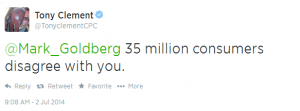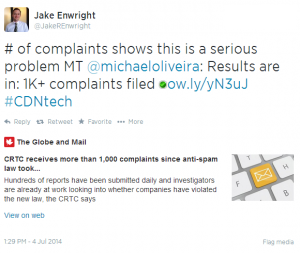The government couldn’t be happier. The CRTC has reported since the that it has already received more than a thousand complaints since the anti-spam law took effect on Tuesday. CBC reported in the most dramatic fashion: CRTC flooded with more than 1,000 anti-spam complaints. “Flooded”!
The Industry Minister’s press secretary went onto Twitter boasting that this is evidence of how serious a problem we have:
How does the sudden tracking of complaints show spam is a serious problem? 10 years after there was an anti-spam task force – that’s right, 10 years – the press secretary to the Industry Minister says that 1000 complaints “shows this is a serious problem.”
The reality is that 1000 isn’t really such a large number. Remember that there are more than 30 million internet users in Canada and there are billions of spam messages being trapped by Canadians’ email systems every day – most never reaching the end user. The 1000 complaints from 35 million users should be compared to about 500 complaints being received by the CRTC every day for violations of the national Do Not Call List – a system that has been operating for more than 5 years already. There are only about 40% as many phone numbers in the DNCL as there are email users. So the CRTC was not “flooded” with complaints.
Indeed, just last week, CRTC chair Jean-Pierre Blais boasted that the commission was over-staffed in anticipation of CASL coming into effect: “we have more than enough human and technical resources to do whatever is needed to ensure the law is upheld.”
Unfortunately, the number of complaints doesn’t indicate anything about the effectiveness of the solution. Or the lack of effectiveness of this government’s solution. Or the cost to the economy of what has been imposed.
One might have hoped that 10 years would have produced better evidence.
Of course, proper evidence might have avoided the regulatory over-reach of Canada’s Anti-Spam Law (CASL). Jeffrey Graham, of Borden Ladner Gervais asks “Why would it not be enough for the law to simply provide that if there is an existing relationship, broadly defined, and an effective opt out right clearly identified in the promotional emails, the public interest is adequately protected?” In his OpEd in the Financial Post, he says that the compliance costs could be in the hundreds of millions of dollars.
In a commentary called “Spamaflop! Why Ottawa’s spam ban law is absurd and should be overturned“, Terence Corcoran cites Barry Sookman of McCarthy Tetrault in considering the impact on Canada’s economy:
The anti-spam law, he says, is an infringement on “commercial speech,” which is guaranteed under the Charter of Rights and Freedoms. The law “ignores that consumers benefit from receiving useful information about products and services” ‘ from businesses. It increases competition and expands consumers’ market knowledge.
Commercial Electronic Messages – and I mean otherwise legal, non-fraudulent, non-malicious messages – increase competition and expand market knowledge. Why would we want to block increased competition?
Recall from my blog post earlier this week that former Industry Minister Tony Clement claimed that 35 million Canadians disagree with my views on CASL.
If there are consumers who believe that CASL is worth the costs of compliance for Canada’s business community, I wonder if they understand the costs that are ultimately being borne by them? The direct costs will ultimately be passed on to Canadian consumers, as will the costs associated with reduced competition and reduced market knowledge.
Our government has imposed yet another impediment to the adoption of e-commerce and information technology in Canada. It is another contributor to lower levels of competition across the board in Canada’s economy.

